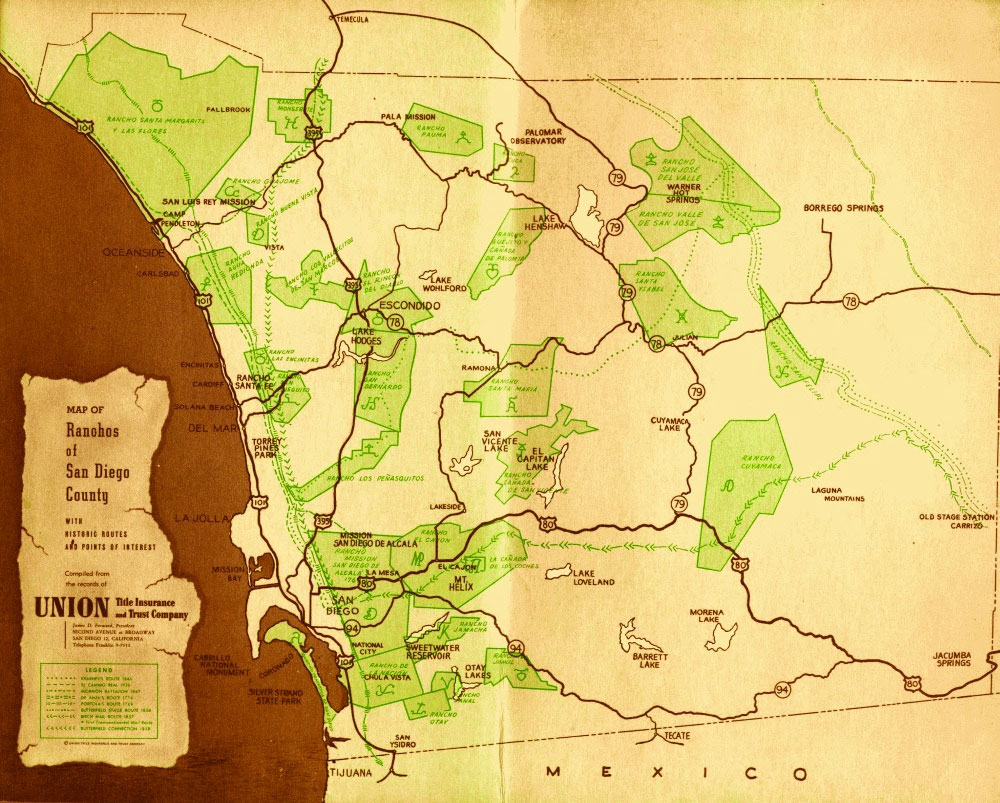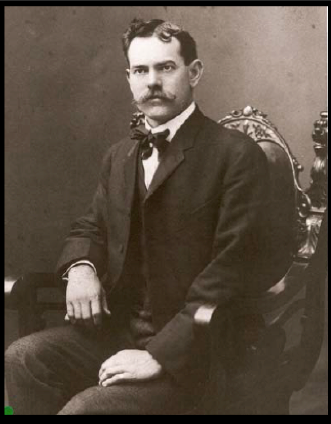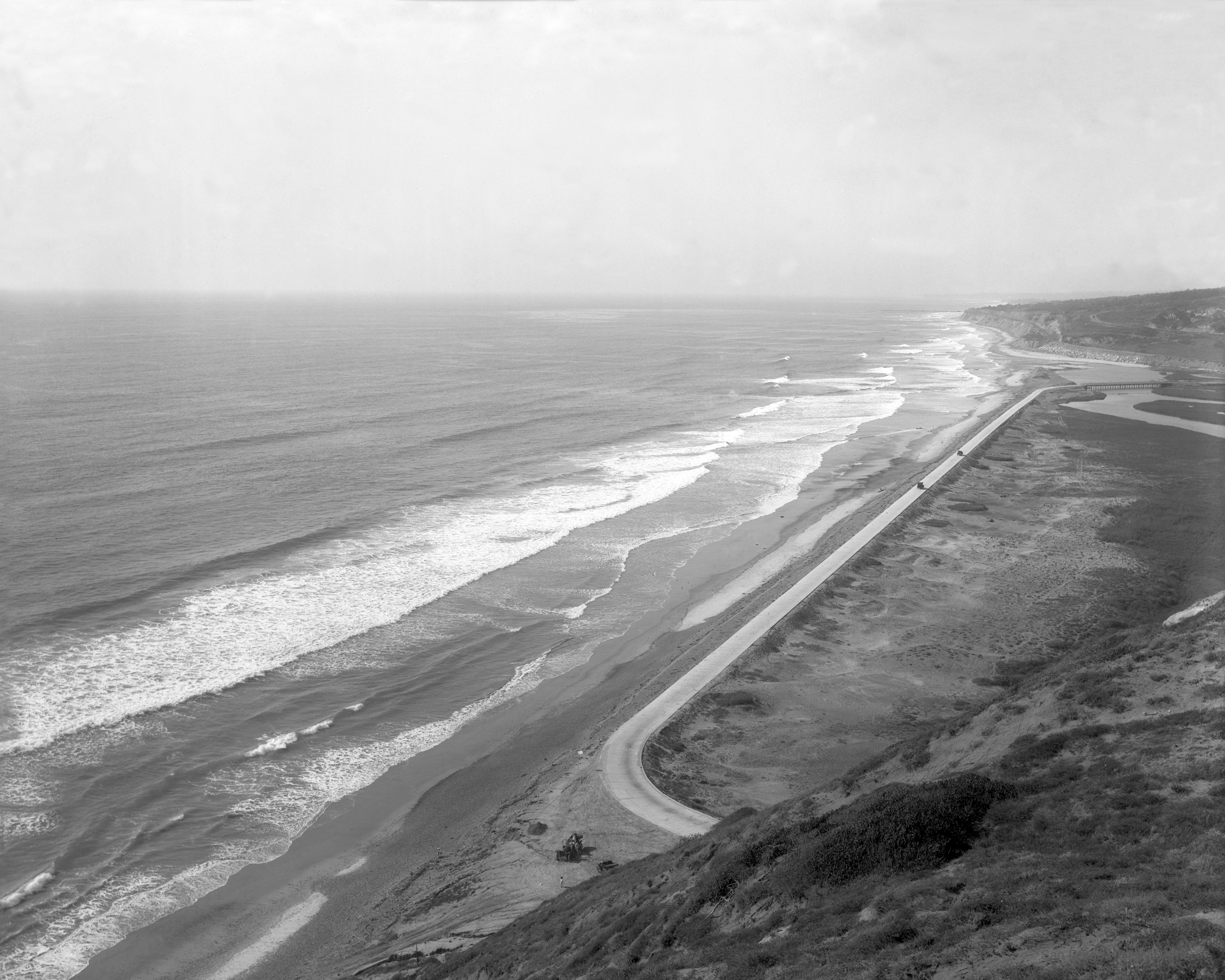HISTORY
FIRST CONTACT
European contact with the Kumeyaay in coastal San Diego began on September 28, 1542, when Juan Rodriguez Cabrillo entered San Diego Harbor and named it San Miguel. A subsequent contact with Spanish explorers occurred later in 1602 when Sebastian Vizcaino sailed into the bay and renamed it San Diego de Alcalá. Kumeyaay culture and society remained stable until the advent of mission system and displacement by Hispanic populations during the eighteenth century (Pignolio 2010). Establishment of the mission system in San Diego was initiated with the building of the Mission San Diego de Alcalá in 1769, located in modern-day Mission Valley just east of Interstate 15. While many of the Kumeyaay initially resisted missionization, the introduction of European diseases greatly reduced the native population during this period and contributed to the breakdown of cultural institutions. De facto Native American control of the southern California region ended several decades later.
We are not makers of history. We are made by history.
– Martin Luther King, Jr
SPANISH PERIOD
The Spanish Period (1769-1821) represents a time of European exploration and settlement that involved dual military and religious contingents based out of the San Diego Presidio and the missions located in San Diego and San Luis Rey. Most of the remaining Kumeyaay during this time period were forced to convert and relocate to the mission, where they were used as a source of labor. The mission system introduced horses, cattle, agricultural goods, and implements from Europe, as well as new construction methods and architectural styles. While Spanish control of the southern California region ended with the separation of Mexico from Spain in 1821, many of the Spanish institutions and laws remained.
MEXICAN PERIOD
The Mexican Period (1821-1848) began with Mexico’s independence in 1821. At that time, cowhides were one of the few items in California that could be produced in abundance and shipped long distances (Wade 2009). The first private land grant in San Diego, Rancho Peñasquitos was established in 1823 when Captain Francisco Maria Ruiz, the San Diego Presidio Commandant, was awarded 4,243 acres that included eastern portions of Los Peñasquitos Canyon (Ibid). When the mission system was secularized in 1834, many Native Americans were dispossessed and Mexican settlement was further expanded on lands previous under mission control (Mealey 2010). During this period, Rancho Peñasquitos was expanded by an additional 4,243 acres to the west toward Los Peñasquitos Lagoon that included the remaining portions of Los Peñasquitos Canyon. An early settler of San Diego, Franciso Maria Alvarado, Ruiz’s nephew, purchased the Rancho Peñasquitos in 1837 (Wade 2009). The proximity of Rancho Peñasquitos to the main road between San Diego and Yuma most likely helped the rancho to prosper in its early years since it could provide hides, tallow, and beef to both travelers and military personnel during the Mexican-American War (Ibid). Historic reports mention that the United States Army collected over 100 head of cattle from Rancho Peñasquitos in 1846 when General Stephan Watts Kearny chose the rancho as resting place for his Army of West after the Battle of San Pasqual (Ibid). The Mexican Period ended when Mexico ceded California to the United States after the Mexican-American War ended in 1848.
UNITED STATES
Shortly after the United States took control from Mexico, gold was discovered in California. This resulted in a rapid influx of American and Europeans that quickly displaced the cultural influences and institutions developed during the Spanish and Mexican Periods. Remaining pockets of de facto Native American control were eliminated by the time of the Garra uprising in the early 1850s (Phillips 1975). While cattle ranching prospered to meet the demands of the growing populations of central and northern California, the prosperity was short-lived and declined after the 1850s due to several factors that included drought, disease and changing land use priorities (farming and homesteads over large ranches) facilitated by the United States control over California (Wade 2009). Few Mexican ranchos remained intact due to land use claim disputes caused by the homestead system that facilitated American settlement within the southern California region (Ibid). Rancho Peñasquitos stayed within the Alvarado family after the Mexican American War, when the United States Congress reassessed and confirmed land ownership in California beginning in 1851 (Ibid). Approval for the land ownership title for Rancho Peñaquitos was granted to the Alvarado family in 1876 by the U.S. Congress and their Board of California Land Commissioners (Ibid). The rancho was sold to Colonel Jacob Taylor in 1888, most likely to offset the debt incurred during negotiations to prove ownership of the land (Ibid). The U.S. Government’s establishment of the reservation system between 1877 and 1891 forced the relocation of the Kumeyaay, took away many of their freedoms, and forever changed what remained of their lifestyle (Carrico 1987; Castillo 1978; Shipek 1987).
RANCHING IN LOS PEÑASQUITOS CANYON (1823–1962)
Ranching in Los Peñasquitos Canyon began in 1823 when Captain Francisco Maria Ruiz established Rancho Los Peñasquitos in the upper watershed. Following the separation of Mexico from Spain in 1821, the Secularization Act of 1833 eliminated mission-owned lands and allowed private ranchers to begin to settle within San Diego. Driven initially by the foreign demand for hides and tallow, cattle ranching flourished during this time at the rancheros of San Diego County, including Rancho Peñasquitos which expanded in 1834 to include the lower portion of Los Peñasquitos Canyon.
The cattle industry in San Diego once again became lucrative in the mid-1800s as a result of the Mexican–American War and the discovery of gold in the Sierra Nevada Mountains. Historic reports mention that the United States Army collected over 100 head of cattle from Rancho Los Peñasquitos in 1846 when General Stephan Watts Kearny chose the rancho as resting place for his Army of West after the Battle of San Pasqual (Cole and Wahl 2000). With populations in central and northern California growing rapidly, beef was now in high demand and San Diego rancheros prospered. However, prosperity was short-lived and cattle ranching declined after the 1850s as a result of several factors, including drought, disease, and changing land use priorities (farming and homesteads over large ranches) (Wade et al. 2009).
Cattle ranching reemerged in San Diego County in the early 1900s as a result of advancements in bovine vaccines and modern pumping equipment that improved irrigation within pastures and enabled the development of wells for water supplies. Quite possibly the most prominent cattle rancher in San Diego and Riverside Counties, George Sawday quickly amassed a cattle empire that included Rancho Los Peñasquitos. During this period, the average number of cattle in San Diego County ranged from 40,000 to 75,000 depending on range conditions and the market. Big ranches with large herds dominated the industry and Rancho Peñasquitos was considered one of the largest cattle ranches in San Diego (Wade et al 2009). Evidence of ranching activities in Los Peñasquitos Canyon and near LPL still persist in the form of fence posts, barbwire and isolated areas of cattle bones in locations that most likely were used to butcher cattle. However, cattle ranching declined again after the end of World War II, due in part to the pressure from housing development along the coast as a result of the post-war population boom that occurred in Southern California. In 1962, J. Irvin Kahn purchased the area with plans to develop into golf courses and residences. Since that time, the Los Peñasquitos Watershed has been divided up and developed with only select parcels remaining.
Impacts to Los Peñasquitos Lagoon and its Watershed
Burning thick stands of chaparral was a common practice in the ranchos of San Diego, as it allowed grass to grow and also improved access for both cattle and cattlemen (Wade et al. 2009). Prior to the establishment of Rancho Peñasquitos, thick chaparral and a forested riparian zone along the creek made up the dominant vegetation communities within Los Peñasquitos Canyon. To improve the area for cattle grazing, large expanses of chaparral within Los Peñasquitos Canyon were cleared using fire. Sediment cores taken within Los Peñasquitos Lagoon, as part of a paleo-ecological study, show high charcoal values occurring in the mid-1820s that indicate man-made fires, as opposed to charcoal signatures characteristic of naturally occurring fires. After these prescribed burns, areas of chaparral were replaced by large areas of native grasses that could be used for grazing areas for cattle, as evidenced in pollen counts taken in sediment cores from Los Peñasquitos Lagoon (Cole and Wahl 2000).
TRANSPORTATION INFRASTRUCTURE & ITS IMPACTS
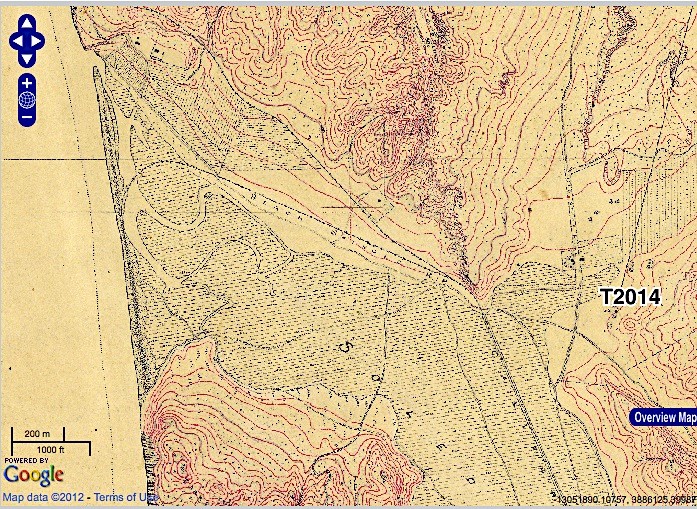
Railroad Alignments
Aside from the Tijuana River National Estuarine Research Reserve (TRNERR), all of the coastal estuaries within San Diego County have been impacted by coastal railway alignments. In Los Peñasquitos Lagoon, two separate railway alignments were constructed across the Lagoon upon elevated berms of compacted fill. The first railway alignment was constructed in Los Peñasquitos Lagoon in 1888 just west of the current alignment of Sorrento Valley Road. The 1888 railway alignment through Los Peñasquitos Lagoon was abandoned in 1910 when a new alignment was completed that moved the tracks over to the coastal bluffs of Del Mar. The elevated berm from the 1888 alignment was later converted into a sewer berm and vehicle access road for SDGE before it was removed completely in 1998.
The 1910 railway alignment was moved to the center of the Lagoon and built on top of an elevated berm of compacted fill. During construction of the 1910 railway alignment, the ocean inlet at Los Peñasquitos Lagoon was moved south from its historic location to allow the railway line to exit the Lagoon at its northwest corner and proceed along the coastal bluffs to Del Mar. The upper bridge constructed as part of Highway 101 in 1932 spans this section of the railway and the historic lagoon mouth location. The berm used for the 1910 alignment cut off several historic tidal channels and divided the Lagoon into an eastern basin and a western basin while reducing the the overall tidal prism (i.e., total volume of ocean water entering and exiting the lagoon during a tidal cycle). The new railway alignment incorporated only three bridge spans to convey flows from the watershed toward the ocean. Storm flows can proceed through the bridge spans and toward the Lagoon mouth during small flood events and dry-season flows.
Regional efforts to expand and improve the service capability of the railway have been considered through the Los Angeles to San Diego Rail Improvement Program (LOSSAN). Key components of this program include double tracking and retrofitting of existing railway bridges between 2015 and 2017, including the three that occur within Los Peñasquitos Lagoon. Selection of the preferred alignment through the Lagoon will most likely occur during the remaining phases of LOSSAN and implementation is projected to occur in 2030. Currently, several railway alignments are proposed since the current one may not be feasible in the long-term because of its location along erosive coastal bluffs just north of the Los Peñasquitos Lagoon as well as community pressure from Del Mar. Regardless of which alternative is selected, it appears that the railway alignment will remain within Los Peñasquitos Lagoon rather than relocating outside of the Lagoon (e.g., along the median of I-5).
Coast Highway and Highway 101
The first incarnation of the coast highway in San Diego County was completed in 1915 and was composed of a 15-foot strip of concrete that hugged the coast. While this road passed through Los Peñasquitos Lagoon, it did so using a different alignment than what is currently used today. Heading south, the road cut inland from the coast on the Lagoon’s northern border along what is now Carmel Valley Road and rejoined the coast near the current location of the South Beach parking lot at TPSNR by way of a bridge that crossed the Lagoon’s western-most channel. This alignment preserved the coastal strand and dunes of Torrey Pines State Beach as well as the Lagoon’s meandering inlet.
In 1932, the original coastal road at Los Peñasquitos Lagoon was rerouted with the construction of Highway 101, now referred to as North Torrey Pines Road. Elevated on a berm of compacted fill, Highway 101 ran the entire length of Los Peñasquitos Lagoon’s western boundary along Torrey Pines State Beach, effectively separating the Lagoon from its barrier beach. The Lagoon inlet was “preserved” under the lower bridge (Coppock 1985) since the Lagoon’s historic inlet location to the north had been obstructed by the construction of the railway alignment in 1925 followed by the construction of the upper bridge for Highway 101.
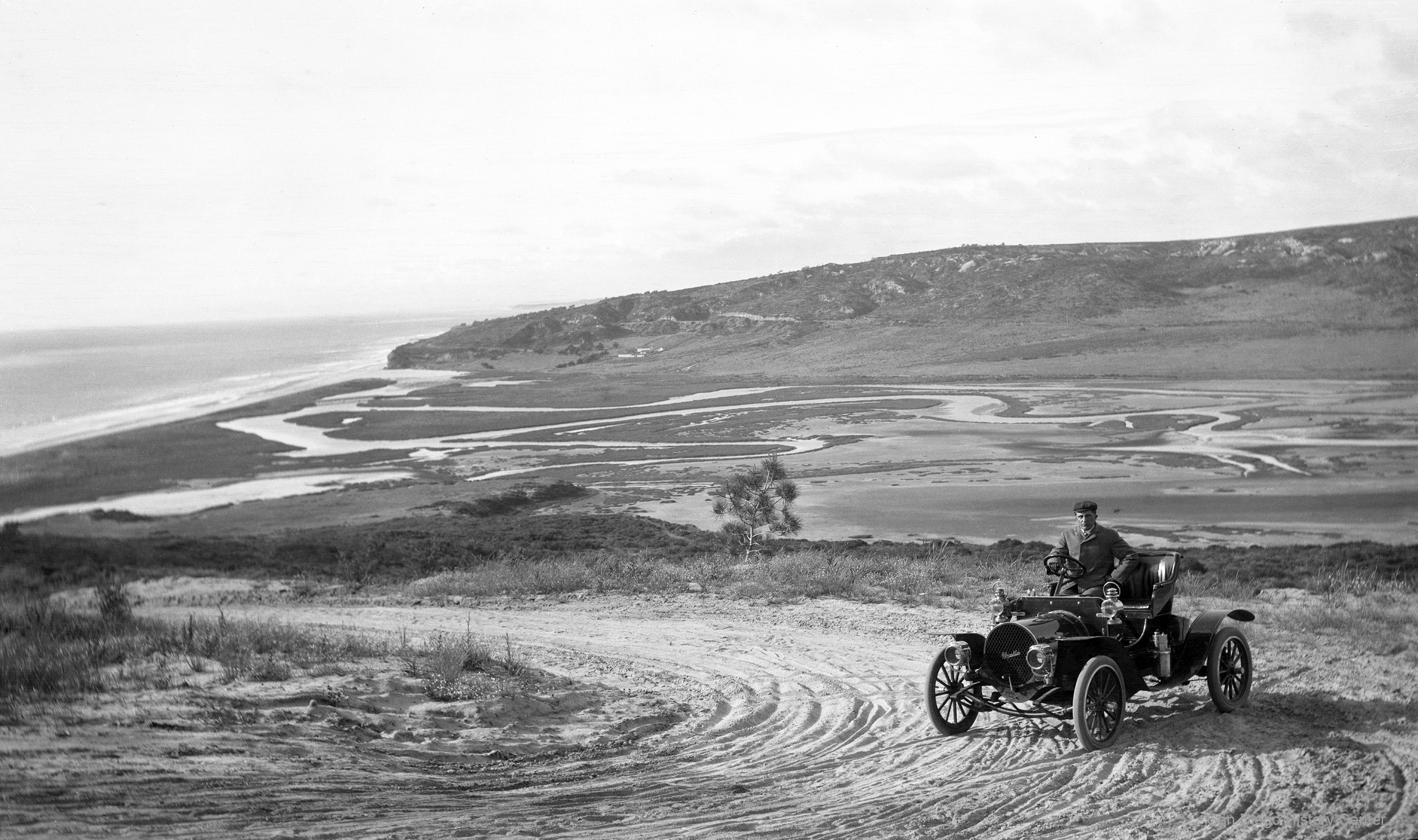
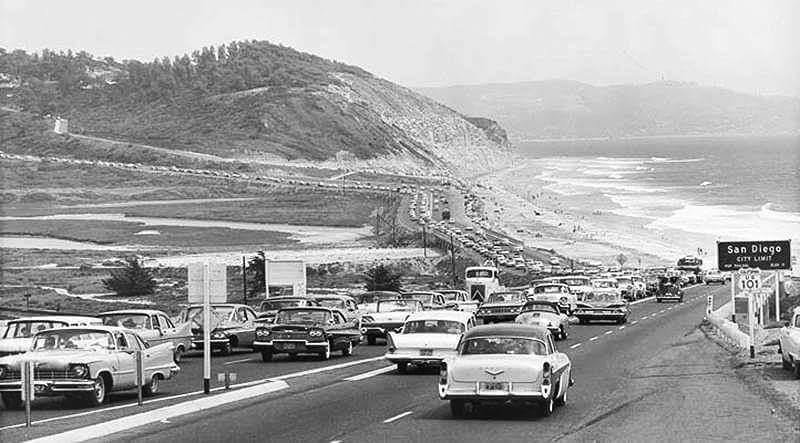
North Beach Parking Lot
Built in 1968 near the Lagoon inlet, the North Beach parking lot was developed to generate revenue for State Parks and to provide improved access to Los Peñasquitos Lagoon, the northern stretch of Torrey Pines State Beach, and the Torrey Pines State Natural Reserve Extension. The parking lot is triangular in shape and is accessed via Carmel Valley Road at McGonigle Road/Del Mar Scenic Parkway. The lot contains public amenities, including bathrooms, showers, and an access ramp to Torrey Pines State Beach, which was greatly improved in 2004-2005 as a feature of the new lower bridge at North Torrey Pines Road. The parking lot also provides great viewpoints for Los Peñasquitos Lagoon, along with informational panels describing management efforts at the inlet and bird species visible within the Lagoon. Public access to Los Peñasquitos Lagoon is not provided from the North Beach parking lot, although it does serve as staging area for biological monitoring and other scientific efforts within the Lagoon.
Interstates 5 & 805
I-5 is the main north/south interstate highway on the west coast of the United States and was constructed to replace Highway 101 as the major public transportation corridor along the coast. I‑5 was extended south to San Diego and opened in 1964. The demand for a highway to service inland areas in San Diego resulted in the construction of I-805, which merges with I-5 at its northern extent just east of Los Peñasquitos Lagoon. I-805 was opened in 1975. The I-5/805 merge was expanded in 2007 to include 22 lanes at the widest point. Additional improvements to this section of freeway are being considered under the San Diego Association of Governments (SANDAG) North Coast Corridor Public Works Plan and may include a flyover lane to improve connectivity with State Route 56 that provides vehicular access between the coast and Interstate 15 to the east.
